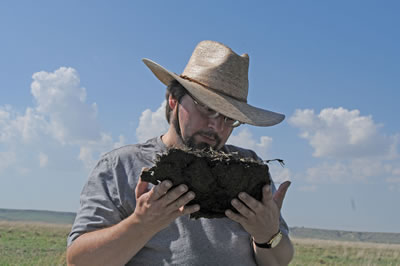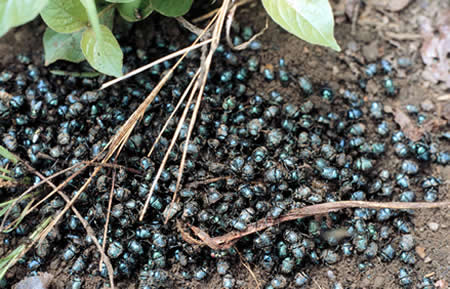|
After a short period with the Zoological Research Institute and Museum Alexander Koenig in Bonn, Germany, he became a research entomologist with The Natural History Museum, London, UK, in 2000. Before joining the Denver Museum of Nature & Science in January 2007, he was the head of the beetle division in London. Dr. Krell is Editor-in-Chief of the Denver Museum of Nature & Science Annals and commissioner of the International Commission on Zoological Nomenclature. He is chair of the Commission's ZooBank Committee, responsible for development and implementation of an Official Register for Animal Names. Dr Krell's specialty is taxonomy, systematics, and ecology of scarab beetles, especially dung beetles. Recording and explaining the high diversity in this insect group, as well as exploring the effects of anthropogenic habitat changes on dung beetle communities, are two main areas of his research. He is also working on fossil scarab faunas, has published 168 scientific papers and has done fieldwork on all continents except Antarctica, with the main focus on Africa. |
|
What happens if dung beetles are missing in a grassland ecosystem could be watched in Australia last century: Ranchers lost large areas of pastureland because it became sealed by cow dung. Biting flies developed in the billions, creating a serious problem for both livestock and the rural human population. Native Australian dung beetles were not adapted to the unusual, soft, muddy type of poop that a domestic cow produces every other hour. In 1965, the Australian government started a twenty year long project to introduce foreign dung beetles to Australia and succeeded in establishing 23 species from Africa and southern Europe which largely resolved the sticky problem. If we compare our Plains with grasslands elsewhere in the world where large mammals are producing a lot of dung, we look pretty poor. If a Cape buffalo defecates in the African savanna, the result is almost gone within a day or two. A portion of human feces, a very attractive resource for dung beetles, is used up within a couple of hours. The dung beetle fauna of the North American plains is currently rather poor, heavily invaded by European species and doesn't seem capable of dung recycling at a significant scale. When 30-60 million bison had roamed the Great Plains and produced at least 100-200 billion dung pats per year, a more abundant dung beetle fauna can be assumed. Since bison are lacking much of the medical treatment, such as antihelminthic and anti-biotic drugs that cattle get administered, bison dung is likely to be more suitable to maintain an abundant dung beetle fauna. If the presence of bison in an area results in a recovering dung beetle fauna, bison herds could have positive implications on the maintenance of soil quality in rangelands. To find out whether bison dung can sustain a more efficient dung recycler fauna is a goal of the Denver Museum of Nature & Science Entomology program. This study involves monitoring the beetle fauna for a decade after bison were reintroduced in an area, finding out whether the fauna gets richer, more abundant, or changes species composition. When the Plains Conservation Center decided to have a bison herd on the Bijou Creek Property in fall 2007, we jumped on this opportunity and are monitoring the dung beetle fauna since May 2008. Come to Café2 and learn more about Frank Krell's work in Colorado and Africa on the little gourmands of the resource we all produce every day but rarely talk about. |

 Dr. Frank-T. Krell (shown here with bison poop at Bijou Creek) is the curator of entomology in the Department of Zoology of the Denver Museum of Nature & Science. He received his diploma in biology (1992) and his doctorate (1996) from the University of Tübingen in Germany. His postdoctoral research took him to the Ivory Coast in West Africa where he led a project on scarab beetle biodiversity with the University of Würzburg, Germany.
Dr. Frank-T. Krell (shown here with bison poop at Bijou Creek) is the curator of entomology in the Department of Zoology of the Denver Museum of Nature & Science. He received his diploma in biology (1992) and his doctorate (1996) from the University of Tübingen in Germany. His postdoctoral research took him to the Ivory Coast in West Africa where he led a project on scarab beetle biodiversity with the University of Würzburg, Germany.

 In grassland ecosystems with large mammals, be it cattle, bison or a diverse fauna as we find it in African savannas, the dung beetle fauna plays a vital role in maintaining soil quality. They break up the droppings and bring nutrient-rich dung into the soil where plant roots take them in. Dung beetles aerate the soil by their digging activity, and they disturb the dung patties enough that dung flies, often biting pests of large mammals, cannot develop in large numbers. Dung beetles also reduce the number of pathogenic worms in pastureland.
In grassland ecosystems with large mammals, be it cattle, bison or a diverse fauna as we find it in African savannas, the dung beetle fauna plays a vital role in maintaining soil quality. They break up the droppings and bring nutrient-rich dung into the soil where plant roots take them in. Dung beetles aerate the soil by their digging activity, and they disturb the dung patties enough that dung flies, often biting pests of large mammals, cannot develop in large numbers. Dung beetles also reduce the number of pathogenic worms in pastureland.